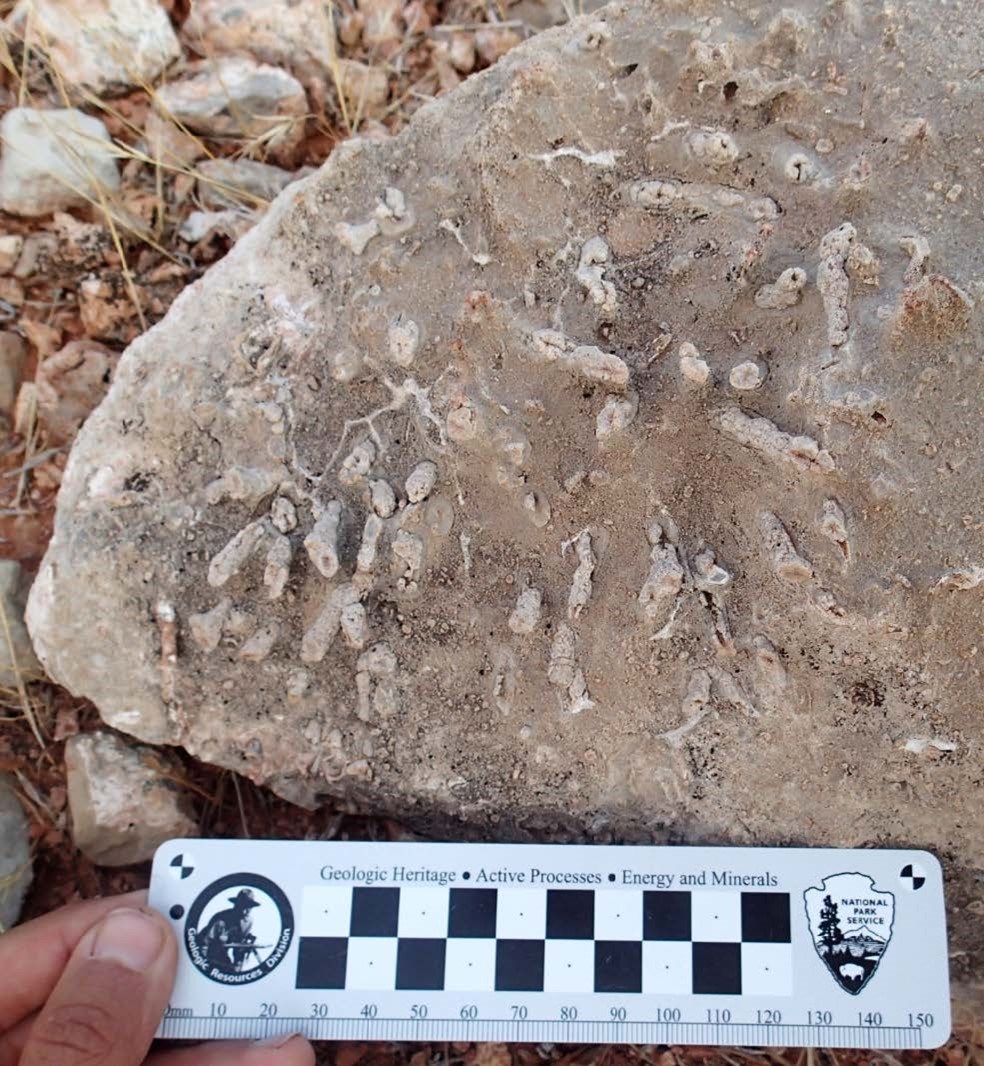Part of a series of articles titled Invertebrate Fossils in National Parks.
Article
Fossil Bryozoans

Introduction
Bryozoans, a type of aquatic colonial animal, aren’t as widely familiar as some groups of invertebrates. However, they are an important part of fossil assemblages in many national parks, and are still around today. Even though they are colonial animals, bryozoan fossils are usually small: the individual animals were microscopic. The colonies themselves were often only a few centimeters or inches in size and often had easily broken structures. For example, many bryozoan colonies had the shapes of delicate lace (fenestrate bryozoans) or branching twigs.
Phylum Bryozoa
Bryozoans, informally known as “moss animals” based on the ancient Greek roots of their name, are filter-feeding colonial animals that live primarily in marine environments. They are also known as “sea mats” or “lace corals.” Bryozoans generally prefer warm, tropical waters but are known to occur worldwide. They first appeared in the fossil record in the Early Ordovician. Today there are both living mineralized and non-mineralized bryozoans, but the non-mineralized forms have a very poor fossil record.
Bryozoans may be confused with corals because both build colonies made of many small individual animals, but individual bryozoan animals (zooids) are much smaller than coral animals, anatomically more complex (they have a one-way digestive tract like us and unlike corals), and live by filter-feeding instead of capturing small prey and using symbiotic algae. Bryozoan colonies can take a wide variety of forms, including: simple mats and encrustations; mounds or domes; branching twigs; densely branched forms; and net-like or lacy forms. Figuring out what genus or species a fossil bryozoan belongs to is usually not easy, because many species produced similar-looking colonies, and were quite variable. It often requires microscopic techniques to tell species apart.
Bryozoan Fossils in National Parks


Bryozoan fossils from the Ordovician Decorah Shale, showing a variety of shapes. Mississippi National River and Recreation Area, Minnesota.

Identification Guide to the Fossils of the Guadalupe Mountains by Mary Carol Coleman and Cameron Coleman.

Branching twig-stye bryozoans. Pakoon Limestone. Grand Canyon-Parashant National Monument.
NPS/2020 Field Inventory.

The bryozoan Archimedes from Mammoth Cave National Park. Top photo by Rick Toomey. Bottom photo.
NPS photo.

NPS photo.
Many different kinds of small bryozoan colonies are known from the Ordovician rocks of Mississippi National River and Recreation Area in Minnesota. Bryozoans were also an important part of the Permian reef of Carlsbad Caverns National Park in New Mexico and Guadalupe Mountains National Park in Texas. Several parks in Arizona and Nevada, including Grand Canyon National Park, Grand Canyon-Parashant National Monument, and Lake Mead National Recreation Area, have extensive records of bryozoans from the Mississippian, Pennsylvanian, and Permian. Bryozoan fossils among the fossils in the Kaibab Formation on the rim of Grand Canyon .
One of the most famous kinds of bryozoan is the screw-like Archimedes from the middle to late Paleozoic. The screw-like fossils represent a central axis that supported a spiraling lacy frond that is rarely found attached. Fossils of Archimedes have been found at several parks, such as Mammoth Cave National Park in Kentucky. Mammoth Cave also has examples of another kind of showy bryozoan, lyre-like bryozoans composed of a V-shaped base supporting a lacy colony.
Featured Parks
-
Carlsbad Caverns National Park (CAVE), New Mexico—[CAVE Geodiversity Atlas] [CAVE Park Home] [CAVE npshistory.com]
-
Grand Canyon National Park (GRCA), Arizona—[GRCA Geodiversity Atlas] [GRCA Park Home] [GRCA npshistory.com]
-
Grand Canyon-Parashant National Monument (PARA), Arizona—[PARA Geodiversity Atlas] [PARA Park Home] [PARA npshistory.com]
-
Great Basin National Park (GRBA), Nevada—[GRBA Geodiversity Atlas] [GRBA Park Home] [GRBA npshistory.com]
-
Guadalupe Mountains National Park (GUMO), Texas—[GUMO Geodiversity Atlas] [GUMO Park Home] [GUMO npshistory.com]
-
Lake Mead National Recreation Area (LAKE), Arizona and Nevada—[LAKE Geodiversity Atlas] [LAKE Park Home] [LAKE npshistory.com]
-
Mammoth Cave National Park (MACA), Kentucky—[MACA Geodiversity Atlas] [MACA Park Home] [MACA npshistory.com]
-
Mississippi National River and Recreation Area (MISS), Minnesota—[MISS Geodiversity Atlas] [MISS Park Home] [MISS npshistory.com]
Last updated: October 24, 2024
